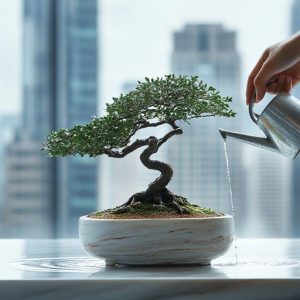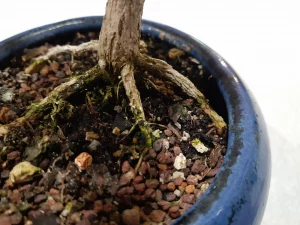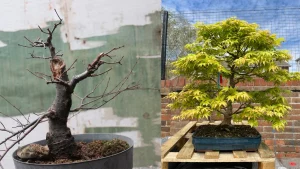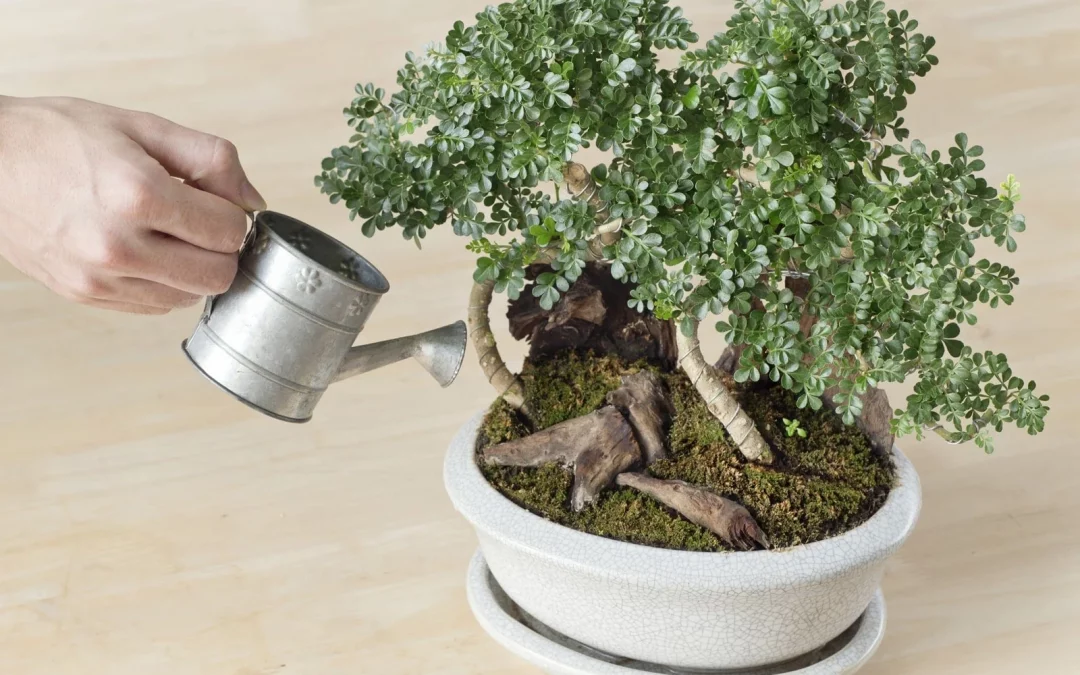Contents
- 1 How to Water a Bonsai Tree Indoors (Avoid Root Rot & Dry Leaves)
- 1.1 Why Watering Matters So Much
- 1.2 How Often Should You Water a Bonsai Indoors?
- 1.3 Best Way to Water a Bonsai Tree Indoors
- 1.4 Signs of Overwatering
- 1.5 Signs of Underwatering
- 1.6 Avoiding Common Watering Mistakes
- 1.7 Expert Tip: Boost Humidity Naturally
- 1.8 FAQs About Watering Bonsai Trees Indoors
- 1.9 Related Articles
- 1.10 Final Thoughts on Watering a Bonsai Tree Indoors
How to Water a Bonsai Tree Indoors (Avoid Root Rot & Dry Leaves)
Watering a bonsai tree seems simple — until you realize it’s the most common reason these tiny trees struggle indoors. Too much water causes root rot, too little leads to crispy, dying leaves. Finding the perfect balance is key.
In this guide, you’ll learn exactly how to water a bonsai tree indoors — when, how much, and what to avoid — so your miniature tree stays healthy, vibrant, and beautifully shaped all year long.
Why Watering Matters So Much
Bonsai trees grow in small, shallow pots, meaning their roots dry out faster than normal houseplants. Water management isn’t just care — it’s survival.
Incorrect watering can lead to:
Root rot (from waterlogged soil)
Wilted or crispy leaves (from dehydration)
Nutrient lockout (from irregular watering)
Weak or stunted growth

How Often Should You Water a Bonsai Indoors?
There’s no one-size-fits-all schedule. Watering depends on:
Tree type: Tropical species like Ficus need more moisture than junipers.
Room conditions: Warm, dry air = more frequent watering.
Pot size: Smaller pots dry faster.
Season: Indoor heating in winter can cause faster evaporation.
Rule of thumb:
Water when the top 1–2cm (½ inch) of soil feels dry — not before.
A Soil Moisture Meter on Amazon is perfect for taking the guesswork out of this — especially if you’re new to bonsai care.
Best Way to Water a Bonsai Tree Indoors
Here’s a simple step-by-step method most bonsai experts use:
- Check the soil – Gently press your finger into the top layer or use a moisture meter.
- Water slowly and evenly – Pour until water runs out of the drainage holes.
- Wait and repeat – After a few minutes, add a second round to ensure deep hydration.
- Drain completely – Never let the pot sit in standing water.
A fine-spout Indoor Watering Can makes watering precise and avoids disturbing the soil surface.
Recommended Tools & Essentials
These simple tools make indoor bonsai watering easier and safer:
💧 Soil Moisture Meter – instantly tells you when your bonsai needs water.
🪴 Humidity Tray for Bonsai – prevents dry leaves and improves air moisture.
🌿 Narrow Spout Watering Can – for gentle, even watering.
They not only prevent root rot but also encourage healthy, steady bonsai growth.
Signs of Overwatering
If you’re watering too often, you’ll notice:
Yellowing leaves
Soft or black roots
Mold on soil
Mushy, sour-smelling soil
Fix:
Let the soil dry for several days before watering again.
Remove any moldy topsoil.
Improve airflow around the tree.
For persistent issues, check out the Royal Horticultural Society’s bonsai care guide.

Signs of Underwatering
If your bonsai isn’t getting enough water:
Leaves turn crispy and drop.
Soil pulls away from the pot edges.
The tree looks limp and tired.
Fix:
Submerge the pot halfway in water for 10–15 minutes to rehydrate soil.
Mist foliage lightly for tropical species.
Maintain moderate humidity to prevent rapid drying.
A Mini Humidifier for Indoor Plants helps tropical bonsai varieties thrive in drier homes.
Avoiding Common Watering Mistakes
| Mistake | Problem Caused | How to Fix |
|---|---|---|
| Using tap water | Mineral buildup | Use filtered or rainwater |
| Watering on a schedule | Over/underwatering | Check soil moisture first |
| No drainage holes | Root rot | Always use bonsai pots with holes |
| Misting instead of watering | Dry roots | Water thoroughly, not just the surface |

Expert Tip: Boost Humidity Naturally
Bonsai trees love moderate humidity, especially tropical species like Ficus or Schefflera.
To raise humidity:
Use a pebble tray under the pot.
Group plants together to trap moisture.
Mist leaves in the morning, not at night.
These simple habits reduce stress and help prevent both root rot and dry leaves.
FAQs About Watering Bonsai Trees Indoors
1. How do I know if my bonsai needs water?
When the top of the soil feels dry or the tree looks slightly dull, it’s time to water.
2. Can I water bonsai trees with tap water?
Yes, but let it sit overnight to allow chlorine to evaporate — or use filtered water.
3. How often should I mist my bonsai?
Once every 2–3 days for humidity-loving types like Ficus or Jade. Avoid over-misting.
Related Articles
Final Thoughts on Watering a Bonsai Tree Indoors
Watering a bonsai indoors is a delicate balance — but once you master it, you’ll rarely face leaf loss or root problems again. With the right tools, timing, and a little consistency, your bonsai will reward you with healthy leaves, strong roots, and a beautifully balanced shape all year long.

